|
< Earlier Kibitzing · PAGE 2 OF 2 ·
Later Kibitzing> |
Jun-17-15
 | | An Englishman: Good Evening: Let's also give a little credit to some fine defense from 16...dxe4 through 21...Nc4, snuffing out White's King side pawn storm with well-timed exchanges. 19...Ne5 was a particularly witty shot. |
|
| Jun-17-15 | | CHESSTTCAMPS: By playing 43.Nd5 instead of Kb6, white might have a slightly better chance of drawing the error 43... a2 (however unlikely at this level of play). |
|
| Jun-17-15 | | dfcx: Wednesday, black has two connected passed pawns. This suggests 40...Nc3+
A) 41.Nxc3 a3 and black can't stop black's pawns from promoting. B) 41.Kb4 Nxb1 42.Kxa4 Nd2  |
|
| Jun-17-15 | | jith1207: Thanks phony benoni, for the valuable tweaks. I missed them. Note to self: never be too arrogant whatever the position (or in Carlsen's case, never try to wrestle with Father Time) might be, till you win. |
|
| Jun-17-15 | | Caissas Clown: Easy , because it's a familiar pattern and tactic in this type of position. |
|
Jun-17-15
 | | Sneaky: I love it when a knight forks a knight. |
|
| Jun-17-15 | | agb2002: Black is one pawn ahead.
White threatens 41.Kxa4.
This threat and the knight on the way of the a-pawn suggest 40... Nc3+: A) 41.Nxc3 a3
A.1) 42.Kb4 a2 wins.
A.2) 42.c6+ Kc8
A.2.a) 43.Nd5 b2 44.Ne7+ (44.Nc3 a2 wins; 44.Nb6+ Kd8 wins) 44... Kd8 followed by 45... b1=Q wins. A.2.b) 43.Kb6 b2 44.Nb5 b1=Q pins the knight - + [Q vs N]. A.2.c) 43.Kc5 a2 followed by 44... a1=Q wins.
B) 41.Kb4 Nxb1 42.Kxb3 g6 (stops h5-g6) wins easily. |
|
| Jun-17-15 | | morfishine: <40...Nc3+> this nice deflection allows the black pawns to advance; the only continuation I looked at was 41.Kxa4 Nxb1 42.Kxb3 Kc6 <sneaky> Well said, delicious! ***** |
|
| Jun-17-15 | | Once: Morf: 40...Nc3+ 41. Kxa4? Maybe not.
It's one of life's little unfairnesses. Knights are not very good at stopping passed pawns. 43...b2 is a nice touch. As Phony says, it means that black will queen on b1 with check and not on a1 without check. And that means that white doesn't have time for knight and passed c pawn mischief. |
|
| Jun-17-15 | | Abdel Irada: Minor piece endings can be downright paradoxical sometimes. Some 20 years ago, I played regularly against a tough Afghan (c. 2230) in Santa Cruz. On one memorable occasion, I went into a bishop, knight and pawn ending a pawn ahead, but Farouk had an advanced c-pawn and some tricks up his sleeve. I had just attacked his bishop with my knight, but, rather than move the bishop, he pushed his pawn. A moment's calculation showed me that I *could* take the bishop, free and for nothing, with check ... and lose. Instead, I had to race back with the knight as fast as possible just to sacrifice it for the pawn, leaving me a piece down rather than a piece ahead. But then it was my b-pawn's turn to indulge its lust to expand, and Farouk's turn to sac his knight to stop it. When the smoke cleared, I was still a pawn up in a fairly simple bishop ending and soon won. And that was a good thing, because I don't think my heart could have stood the strain of having to stop another runaway pawn. ∞ |
|
| Jun-17-15 | | wooden nickel: After 40... Nc3+ 41.Nxc3 a3 42.c6+, I liked 42... Kc8!
Black could otherwise still mess up i.e.
42.c6+ Kc7 White would draw with 43.Kc5 or even
(42.c6+ Kc7) 43.Nd5+ Kc8 44.Nb6+ leads to a draw...
or worse!!
42.c6+ Kc7 43.Nd5+ Kc8 44.Kb6 Kb8 45.c7+ Kc8 46.Kc6 a2 47.Ne7#
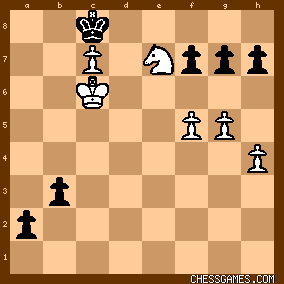
click for larger view |
|
| Jun-17-15 | | TheaN: Wednesday 17 June 2015 <40....?> This endgame position how an obvious first move. White is threatening to gobble up the queenside pawns and the knight on b1 is stopping 40....a3. As such <40....Nc3+!>. A) <41.Kb4 Nxb1  > should be easily won, no compensation. > should be easily won, no compensation. B) <41.Kb6> is slightly more annoying. <41....Nxb1 42.Kb7>. White sacced his knight to put force on the c-pawn. Black is free to promote two pawns, but if white is able to as well it's the question what the value is. <42....Nc3! 43.c6+ Ke7 44.c7 Nb5 45.c8=N+ (c8=Q? Nd6+  ) Kd8 46.Nb6 b2 ) Kd8 46.Nb6 b2  > and white has no way to stop the pawns. > and white has no way to stop the pawns. C) <41.Nxc3 a3> black is forced to play a3 straight away or the deflection didn't help. <42.Kb6 (Nd5 b2  ; c6+ Kc8 ; c6+ Kc8  ) Kc8 ) Kc8  >. The point: black forces white to use the knight to make something of the c-pawn. Now a2 can be tricky because black doesn't promote with check, if he plays up b2, a2 and b1=Q+ he does. >. The point: black forces white to use the knight to make something of the c-pawn. Now a2 can be tricky because black doesn't promote with check, if he plays up b2, a2 and b1=Q+ he does. |
|
| Jun-17-15 | | TheaN: Ah now I still erred in variation C. There is more to this position than some solvers make it to be. After <41.Nxc3 a3 42.Kb6> definitely the best try because the winning 42....b2! is not a natural move <42....Kc8?! 43.f6> to unstress the ending <43....gxf6 44.Nb5>: 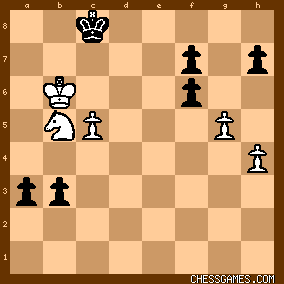
click for larger view<44....a2 45.Na7+ Kd7 46.c6+ Kd6 47.c7 b2 48.c8=Q b1=Q+> looks dangerous: 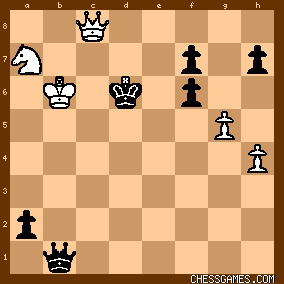
click for larger viewbut after <49.Nb5+ Ke5 50.Qc5+  > and it's most likely a draw. > and it's most likely a draw. The key of the position is that in <any> situation, whatever white plays first, black has to put the pressure on the knight by playing b2. Especially after 42.Kb6 this is a very odd move given the a-pawn can promote more freely and Kc8 seems to block off the c-pawn. Only b2 wins on the spot. |
|
| Jun-17-15 | | Mating Net: Not all pawns are created equal. In this case Black has to play 43...b2 to avoid giving his opponent any chances. It's a case of an exception to the chess maxim that a Rook pawn is kryptonite for a defending Knight. As <Phony Benoni> pointed out, the newly promoted Queen on b1 pins the White Knight. A very instructive moment indeed. |
|
Jun-17-15
 | | Penguincw: I got 40...Nxc3+ 41.Nxc3 a3 42.c6+, but missed the key 42...Kc8 (42...Kc7, 43.Nd5+, with check). |
|
| Jun-17-15 | | whiteshark: <40...Nc3>, and one of the two ♙♙ will win the race. |
|
Jun-17-15
 | | gawain: The winning pawn move ...b2 (intending to advance the a-pawn) at the first available moment after 40...Nc3+ came easily to me. I am pleased about that! I guess I have finally seen enough endings in which an overburdened or distracted knight cannot cover a queening square or squares. |
|
| Jun-17-15 | | patzer2: Here's my look at the game and today's Wednesday puzzle (40...?) with the Opening Explorer (OE) and Deep Fritz 14: <1. e4 d6 2. f4 c5 3. Nc3 Nc6 4. Bb5 Bd7 5. Nf3 e6 6. O-O Be7 7. d3 a6 8. Bxc6 Bxc6> After some clever maneuvering to avoid transposition to more popular opening lines, the players settle on a minor closed Sicilian variation with about level chances for both sides. <9.g4> This attempt at a Kingside attack appears to be too slow and cumbersome. Perhaps that's why it only appears once in the OE. Fritz's first choice is 9. Qe1 when play might continue 9...Nf6 10. e5 Nd5 11. Ne4 Nb4 12. exd6 Bxd6 = as in
M Turov vs V Akhmadeev, 2003. <9... Nf6 10. g5 Nd7 11. h4 O-O 12. f5 Re8> Here I prefer Fritz's choice 12...exf5! 13. exf5 14. Qb6  (-1.15 @ 20 depth) which immediately exploits White's over extended King side pawns and weak King position. (-1.15 @ 20 depth) which immediately exploits White's over extended King side pawns and weak King position. <13. Bf4 b5 14. Qd2 b4 15. Ne2 d5 16. Ng3 dxe4 17. dxe4 exf5 18. exf5 Bxf3 19. Rxf3 Ne5 20. Rf2 Qxd2 21. Bxd2 Nc4 22. b3 Bd6 23. Bf4 Bxf4 24. Rxf4 Ne3 25. Rf2 Rad8 26. Re1 Kf8 27. Rfe2> (diagram below) 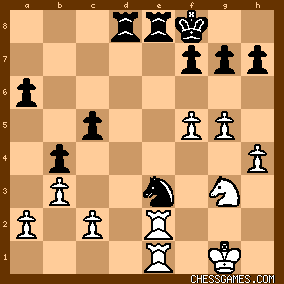
click for larger viewHere (diagram above) <27...Nxc2!> is an instructive combination which snares a pawn and leaves Black with all the winning chances. <28. Rxe8+ Rxe8 29. Rc1 Re1+ 30. Rxe1 Nxe1 31. Kf2 Nd3+ 32. Ke3 c4 33. bxc4 Nc1> (diagram below) 
click for larger viewHere (diagram above) the obvious <34. c5?>, following the maxim "passed pawns must be pushed," is a mistake. Instead, White should play 34. Kd2! when Fritz indicates play might continue 34...Nxa2 35. Ne4 a5 36. f6 gxf6 37. Nxf6 Kg7 38. Nd5 b3 39. c5 Kf8 40. h4 a4 41. c6 Ke8 42. Nb6 Kd8 43. Nxa4 Nb4 44. Kc3 nxc6 45. Nc5 Ne5 46. Kxb3 =. <34... Nxa2 35. Kd3 b3 36. Ne4 a5 37. Nd2 a4 38. Kc4 Ke7 39. Nb1 Kd7 40. Kb5 Nc3+!> This solves our Wednesday puzzle with a move that looks easy after <41. Nxc3 a3>. But it hides a lot of complexity in the follow-up. <42. c6+>
If 42. Kb4, then Black wins with 42...a2 43. Kxb3 a1=Q  . . <42... Kc8!> This follow-up, which avoids a few traps and swindles, is necessary for the win. If 42...Kd8??, Black throws away the win and loses after 43. Kb6! a2 44. Kb7 a1(Q) 45. c7+ Ke7 46. c8(Q)  (+2.41 @ 20 depth). (+2.41 @ 20 depth). If 42... Kc7?, White swindles a draw after 43. Kc5 a2 44. Nd5+ Kb8 45. Kb6 a1=Q 46. c7+ Kc8 47. Ne7+ Kd7 48. c8=Q+ Ke7 =. <43. Kb6 b2! 1-0> This precise move forces White's resignation as the pawn will promote on b1 with no complications. If 43...a2, Black can still win but it gets complicated and risks giving White drawing chances after 43... a2 44. Nb5 a1=Q 45. Nd6+ Kd8 46. c7+ (diagram below) 
click for larger viewHere (diagram above) Black must find 46...Ke7! (not 47. Kd7? 47. c8 =-Q Kxd6 =) when play might continue 48. 47. c8=Q Qd4+! 48. Ka5 Kxd6! 49. Qb8+ Kc6 50. Qxb3 Qd5+  . . |
|
| Jun-17-15 | | JohnBoy: Agreed, <Phony... 43...b2 is a nice little touch>. Puts the final nail in the coffin. |
|
| Jun-17-15 | | morfishine: <Once> Good evening sir! I hope you realize I was just striving to find some way out for White. Of course, we can see now that 40.Kb5 was a horrendous blunder <Abdel Irada> Nice post, brings back memories ***** |
|
Jun-17-15
 | | Bubo bubo: Black protects the Pa4 while forking White's king and knight with 40...Nc3+! If White captures, he cannot stop the black pawns after 41...a3. Otherwise he just loses his knight. A knight forking another knight, that's cool! |
|
| Jun-17-15 | | BOSTER: According to Nimzo the passed pawn should be blocked, and white playef 39.Nb1 in the pos. on diagram
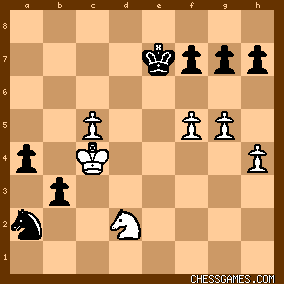
click for larger view But what if white played Kb5, and if Nc3+ Kb4.
Maybe Nimzo was wrong? |
|
Jun-17-15
 | | perfidious: There are exceptions to every rule and the greatest players are capable of approaching positions in concrete fashion, not relying on generalities. |
|
| Jun-18-15 | | patzer2: <morfishine: <Once> Good evening sir! I hope you realize I was just striving to find some way out for White. Of course, we can see now that 40.Kb5 was a horrendous blunder> Yes 40. Kb5? did make it easy for Black to win with 40...Nc3+!  (-9.43@ 23 depth, Deep Fritz 14). (-9.43@ 23 depth, Deep Fritz 14). However, finding a saving move for White is difficult. After a long look with the computer, the best and only try for Black to save the game here appears to be 40. h5! when play might continue 40...g6 41. fxg6 fxg6 42. hxg6 hxg6 43. Nd2 Kc6 44. Nb1 b2 45. Na3 Nc1 46. Kc3 Kxc5 47. Nb1  (-1.19 @ 27 depth, Deep Fritz 14) with good chances for a draw. (-1.19 @ 27 depth, Deep Fritz 14) with good chances for a draw. |
|
| Jun-18-15 | | kevin86: The knight cannot stop two pawns as a dog cannot catch two squirrels. Black's knight is expendable. |
|
 |
|
< Earlier Kibitzing · PAGE 2 OF 2 ·
Later Kibitzing> |





































